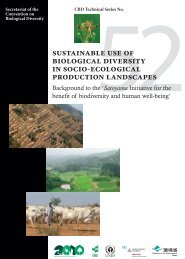INDIAN SCIENCE CONGRESS - India Environment Portal
INDIAN SCIENCE CONGRESS - India Environment Portal
INDIAN SCIENCE CONGRESS - India Environment Portal
You also want an ePaper? Increase the reach of your titles
YUMPU automatically turns print PDFs into web optimized ePapers that Google loves.
Section XIV : Plant Sciences 9<br />
Asparaginase is an important enzyme used as an anti cancer compound. Salt<br />
marsh plant (Suveda monoica) was used for fungal isolation by triple surface<br />
sterilization method. Twenty three isolates of endophytic fungi were evaluated for<br />
asparaginase production using qualitative and quantitative analyses. Seven isolates<br />
demonstrated pink zone around their colonies. Fusarium spp, and Aspergillus spp,<br />
isolated from salt marsh plant were highly active when tested with quantitative<br />
assay. The endophytic fungi with high activity are proposed as a possible asparaginase<br />
source to manage cancer cells.<br />
11. Phytotoxic Effects of Pyrethroid Insecticide on Seed Germination of<br />
Zea mays<br />
Shraddha Sharma and Babita Sharma<br />
Institute of Applied Medicines & Research<br />
9th Km. Stone, Delhi-Meerut Road, Duhai,<br />
Ghaziabad (U.P.)<br />
Keywords : Zea mays cypermethrin,<br />
For the present study Zea mays var. Ganga 2 was selected. The insecticide<br />
chosen for the study was cypermethrin (25% EC). For the study, three different<br />
concentrations of insecticide i. e. recommended dose 0. 05% (x), twice the<br />
recommended dose 0. 1% (2x) and four times the recommended dose 0. 2% (4x)<br />
were taken. The control was tap water. The uniform viable seeds of var. Ganga<br />
2 were soaked in various concentrations of insecticide and tap water. It was found<br />
that seed germination was inhibited at all the used concentrations. The seed vigour<br />
also declined as the concentrations of insecticide was increased from x to 4x.<br />
Various growth parameters like fresh weight and dry weight of the seedling, %<br />
moisture content, number of leaves, number of roots and average root lengths were<br />
adversely affected by the chemical stress induced by insecticide. The reduction in<br />
growth was minimum at the x dose and was maximum at 4x dose of insecticide.<br />
?-amylase activity also declined in response to pesticide treatment. Decrease in<br />
enzyme activity was maximum at 4x concentration. A decline in chlorophylls (a, b<br />
and total), carbohydrate, protein, carotenoid and anthocyanin content was observed<br />
in the seedlings exposed to different concentrations of insecticide.
















